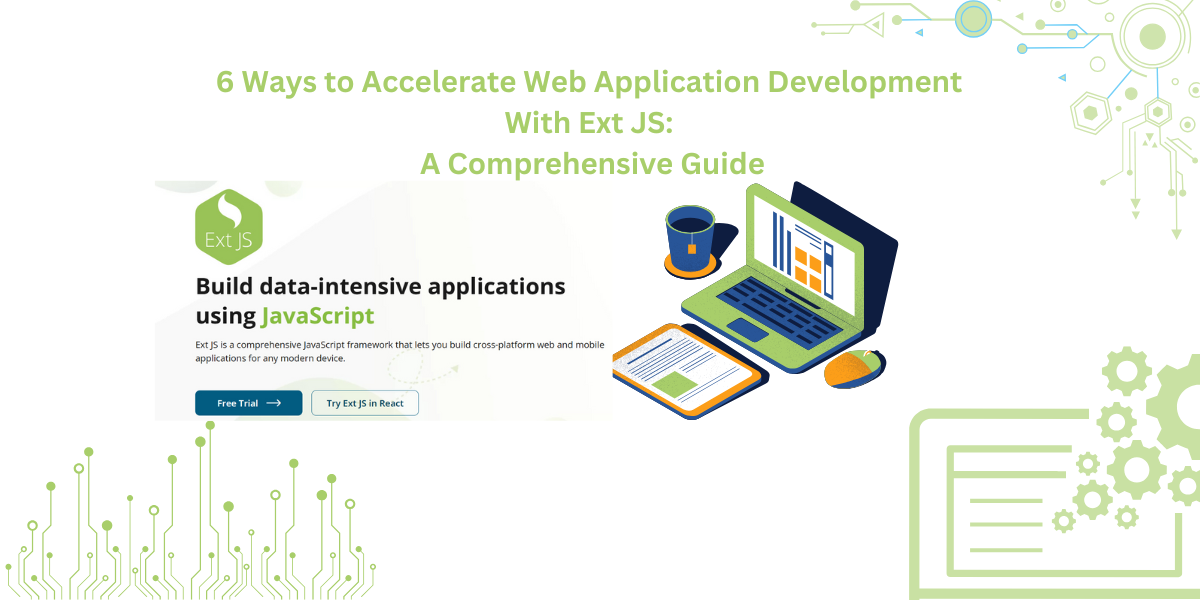6 Ways to Accelerate Web Application Development With Ext JS: A Comprehensive Guide
Creating an app that really works for your business can be tricky, but the right tools make all the difference. While apps can simplify how businesses operate, actually creating one that’s fast, user-friendly & full of useful features can take time and effort. That’s where Ext JS comes in.
A lot of people think app development is just about writing code, but there’s more to it than that. You need the right tools, a good team, and a creative approach. Ext JS helps you cover all those bases. It comes with ready-to-use features, tools for testing and fixing issues, and support for connecting to databases- everything you need to speed things up and work smarter.

In this article, we’ll walk you through 6 simple strategies to save time when developing with Ext JS. You’ll learn how to reuse components, make teamwork more effective, and fix bugs faster. We’ll also touch on the skills needed, where the web development framework is needed, and how to avoid common mistakes. Let’s dive in.
Websites vs. Web Apps: What’s the Real Difference?
People sometimes mistake the two while discussing online platforms. While they might look the same on the surface, they’re developed for other purposes & have other approaches. Knowing the difference is important, especially if you’re about to introduce a visual solution for your business or service. Here’s a brief comparison to help you get an idea:
| Feature | Website | Web App |
|---|---|---|
| Purpose | To share information | To allow users to interact and perform tasks |
| Interaction | Mostly read-only | Fully interactive with user input |
| Examples | Company page, blog, news site | Online banking, email platforms, e-commerce apps |
| Functionality | Static or limited interactivity | Dynamic and task-oriented |
| User Personalization | Minimal or none | High—content updates based on user data |
| Device Compatibility | Works on browsers, may not adapt to all devices | Responsive and optimized for multiple devices |
| Development Complexity | Usually simpler and quicker to develop | More complex, often requires backend integration |
| Updates | Manual content updates | Real-time updates based on user activity |
While sites are wonderful for presenting content & helping users learn more about a brand or topic, web apps take it one step further. They enable individuals to engage, perform tasks & receive tailored experiences. Whether it’s shopping online or checking your bank account, web apps provide dynamic functionality beyond what the standard site can do.
Understanding the distinction between enables you to pick the platform that is best for your purposes. If you are looking to offer valuable content, a website might be enough. But if your users need to take action or interact with your services, a web app is the best option.
Understanding Web Application Development
The best framework for web application development is the process of creating apps you can run directly in a web browser – no downloading or installation required. These are interactive & they can accomplish many different tasks, and you can access them from any device that has an internet connection.
It normally begins with determining what the app should need and then creating how it should look and function. Next, programmers code, test meticulously to catch any problems and finally make the app available for users to use.
Developers require a combination of skills to accomplish this effectively. Frontend development is all about the components that users see and interact with, utilizing languages such as HTML, CSS & JavaScript to design the app’s layout and functionality.
In order to track changes & collaborate well with other people, developers often use software such as Git. On the backend, coding is responsible for handling things such as storing data & reacting to user action.
Additionally, it must look good and function well on every device, including desktops, tablets & phones. This is done with responsive design, so it makes sure it adapts to different screens.
Other useful skills are making the app easily discoverable on search engines (SEO), creating user-friendly interfaces (UI/UX) & preventing errors with debugging. Rapid web development framework are also widely used by many developers, which accelerate the entire process and simplify creating applications.
Also Read: Why Low-Code Application Development Software Is Gaining Momentum in 2025
Essential Skills You Need for Web App Development
The top framework for web development has evolved a lot & now it covers a broad scope of skills. Some of the most important skills that each developer must be familiar with are HTML, CSS, JavaScript, server-side programming languages, databases, version control & web development frameworks.
These abilities are all essential for creating a successful application, and we will go into more detail below to explain what they are and why they are essential.
Front-End Programming Languages
These are used to build everything you see and interact with on a website or web app. Think of them as the tools behind the layout, design & behavior of a page.
- HTML is used to structure the content, such as headings, paragraphs, images & links.
- CSS controls how that content looks. It handles colors, fonts, spacing, and overall visual design.
- JavaScript brings your web page to life. It adds interactivity – like buttons that respond when clicked, animations, or info that updates without refreshing the page.
Together, these languages shape the user experience and make both attractive & functional.
GIT
It is a popular tool used to keep track of changes in their code. Think of it as a save button – but way more powerful. If you make a mistake or want to go back to an earlier version, it lets you do that easily.
This is also great for teamwork. Multiple front end web developer vs back end can work on the same project without overwriting each other’s changes. Everyone can contribute their part & it helps merge everything smoothly.
Responsive Design
This is when your web application resizes and appears well on any device – phone, tablet, laptop, or large desktop screen. Everything fits into a different size – the layout, buttons, text & images. It all repositions or resizes so that users can easily interact, regardless of what they’re using.
This is really critical nowadays since so many web users browse on their smartphones. If your application isn’t properly optimized for mobiles, you’ll lose people. This ensures that everyone gets the same smooth & seamless experience, regardless of screen size.
Back-end Web Programming
It is all about what occurs behind the scenes of web design and development. It’s the part users aren’t aware of, but it’s what actually makes the app function.
This is where the logic of the app lives. It handles things such as storing information, processing user input & loading the correct content at the correct time. Developers use server-side languages like PHP, Python, or Java to cause it all to happen on the web server.
SEO
It is all about making your application appear in search results – like Google. The higher it ranks, the more likely people are to find and visit it.
Good search engine optimization is about having the appropriate words, creating useful content & ensuring your site loads quickly and is accessible on all devices. It’s a smart method of getting seen by more people without spending money on ads.
UI-UX
It stands for User Interface – that’s what the app does look like, such as layout, buttons, colors & fonts. It’s all about how easy and smooth it is to use.
Together, UI & UX ensure your app isn’t only pretty but also functioning for users. A well-designed keeps visitors occupied, facilitates finding what they seek with ease, and makes them have a good feeling about it.
Program Framework
This is similar to a ready-made toolbox for developers. It has pre-written code, templates & in-built features that help speed up the process of custom web development. Developers don’t have to start from scratch but can use these tools to develop apps more effectively.
There are many different frameworks available out there- each of them has its pros & cons based on what type of application you are developing. Using the right one will save you lots of time and keep your code clean and organized.
Testing and debugging
These are important skills. Testing ensures the application does what it is supposed to do – whether that’s loading correctly, reacting to user input, or showing the correct information.
Debugging is all about finding & correcting bugs in the code. Occasionally, something doesn’t go as planned & that’s alright – what’s important is having the ability to identify the problem and resolve it efficiently. Both of these enable users to provide smooth, stable that users can trust.
Problem-solving
This means being able to spot issues & figure out how to fix them. For developers, this skill is really important because they often run into tricky challenges while building custom web application development. Being good at this helps them come up with smart solutions & keep the project moving smoothly.
Attention to detail
Paying close attention to detail is very important in web development. Even tiny mistakes can cause problems that affect how users experience the app. Being careful helps make sure everything works perfectly and looks just right.
Content Management System
It is a responsive web development tool that assists you in creating, modifying & structuring content on a site without the need to code. WordPress, Drupal, and Joomla are some of the most popular examples. These systems simplify website management even for non-tech experts.
Creativity
It is important because it helps come up with new ideas and better ways to solve problems. It makes applications more interesting, user-friendly, and unique.
Smart Strategies to Speed Up Web App Development
There are certain techniques you can use to boost the development process and enhance productivity. Let’s explore these techniques in more detail:
Build Faster in a Highly Composable System
Use pre-built components, libraries & frameworks to save time and effort. This approach allows for integrating and customizing existing elements, ensuring consistency and maintainability.
Reuse Components
Instead of starting from scratch, developers can reuse previously built & tested elements, such as UI or functional modules. Moreover, this saves time, reduces redundancy, and promotes consistency across projects.
Split Team Codebases to Ship Faster
Division of the project into smaller modules or microservices to enable simultaneous work by team members reduces dependencies, facilitates integration and deployment, and, in addition, speeds up the development web development process.
Release Faster, Independently
By adopting agile development methodologies in software development, smaller increments of applications can be released as they are completed and tested. Moreover, faster feedback, validation, and adaptability to changing requirements can be achieved.
Debug Faster with Decoupled Components
Decoupling components in the web application architecture helps to isolate and identify issues more effectively while saving time. Additionally, it improves overall development efficiency.
Quickly Onboard New Developers to Scale Faster
Establish clear documentation & coding standards, as well as provide proper training resources – you can onboard new developers effectively. Moreover, an effective onboarding process enables rapid scaling without compromising quality.
By adopting these steps, the best framework for web application development teams can save time, minimize mistakes & deliver quality apps more effectively. If you are working individually or part of a growing group, these practical steps streamline the process & keep your projects on schedule.
Build Web Apps Faster and Smarter with Sencha Ext JS
Ext JS provides everything you need to build eye-catching web applications that will make you a developer on the next level. It possesses an extensive collection of 140+ UI components that you may come searching for. These include components such as HTML5 calendars, grids, pivot grids, D3 adapters, trees, lists, forms, menus, toolbars, panels, windows, and even more. It is an exceptional tool that helps swiftly create robust web apps, progressive web applications, and portal web apps as well. In addition to that, there can be scenarios where both Ext JS and native apps are used together to create a unified user experience across different platforms.
Makes the Development Process Easier
It simplifies web app development with a lot of pre-built UI components. Developers can save time by reusing existing functionality instead of starting from scratch. Moreover, the framework offers tools for data binding, manipulation, layout management & advanced charting.
Eases Debugging and Application Maintenance
As an exceptional tool, it simplifies web app debugging with a powerful debugging system for inspecting, profiling, and troubleshooting code. It promotes modular development & best practices for code organization, making maintenance easier by isolating & updating specific components without impacting the whole app. Experts can confidently make changes and enhancements in a complex web application without introducing bugs or regressions.
Reduces Code Length
Ext JS reduces code length through a declarative programming paradigm, allowing concise application definition. Developers achieve complex tasks with minimal code, enhancing efficiency and readability. Furthermore, the framework provides built-in data binding, eliminating manual data manipulation. Developers establish direct connections between data models and UI components. Additionally, it helps in automating updates and minimizing the code needed for data management.
Improves Database Proficiency
Moreover, this tool enhances database proficiency by integrating with different back-end technologies and databases. It offers robust data connectivity options, simplifying data consumption from various sources. Advanced data handling mechanisms, like data stores, models, and proxies, make data manipulation and synchronization tasks easy. Developers can efficiently retrieve, modify, and persist data, ensuring optimal performance and database efficiency.
Overall, Ext JS is designed to make web application development faster, easier & more reliable. Whether you’re building a small project or a complex enterprise system, it provides the web development tools & flexibility needed to create high-quality applications that work smoothly across different platforms.
Smart Tips Every Developer Should Follow When Building Web App
Building a web app requires careful consideration. Following best practices ensures quality and efficiency. UX should be prioritized during the design stage. The app must be easy to use and compatible across formats.
Performance is key. Reduce load times with image and script optimization. Speed can also be improved with caching.
Security must be a priority from the start. User input should be verified, and information should be encrypted. Use secure authentication methods to protect user accounts.
Cloud hosting or scalable applications are recommended. This ensures your app can grow as traffic increases.
Always apply best practices. Reusable components can help. If many people are working on the same program, document the code thoroughly.
Test your app regularly. Use unit, integration, and end-to-end testing to identify and fix issues early.
Finally, use version control systems like GIT. These tools simplify collaboration and track changes.
What Challenges Arise When Building & How to Solve Them?
Building web development frameworks isn’t always easy. There are common issues developers encounter that can slow progress or result in issues for users. Understanding these situations & knowing how to deal with them create smooth, reliable & enjoyable web apps.
1. Dealing with Different Browsers
Not all browsers show your web app the same way. One might load it perfectly, while another messes up the layout. The fix? Test your app on multiple browsers like Chrome, Firefox, Safari & Edge. Tools like BrowserStack or Selenium can help you check faster without doing it all manually.
2. Making Sure Your App Can Grow
The more users use your application, the more they need to keep up. If it’s not designed to scale, it may slow down or even crash. That’s why it’s essential to plan it in such a manner that it can scale nicely – using cloud platforms such as AWS or Azure makes it a lot less complicated. Load testing tools such as Apache JMeter can also be employed to identify issues early.
3. Keeping Hackers Out
Security matters. Web applications can be targeted by hackers if there are weak spots in the code. Always check user input, implement secure logins & encrypt sensitive information. Utilities such as OWASP ZAP can scan your application for risks so that you can correct them before they are an issue.
4. Speeding Things Up
No one prefers a slow app. If your web app is loading too slowly, users are likely to leave. To make it faster, minimize your content and images, cache, and experiment with CDNs (Content Delivery Networks) to accelerate content delivery.
5. Making It Work on Every Device
People browse using phones, tablets & desktops. Your app must be visually appealing and usable on all of these. That’s where web based mobile application development framework enters. By employing such as Bootstrap or Tailwind CSS, your apps adapt to whatever screen size without breaking.
6. Working Smoothly as a Team
When more than one developer is developing the same app, things become complicated without coordination. Miscommunication generates bugs & delays. Employing tools such as Git (for code change tracking) and JIRA (for project management) keeps everyone on the same page and the work organized.
Creating is made much simpler by being aware of the obstacles & taking steps to overcome them. As a result, it is more user-friendly, safer & faster.
Conclusion
It is important to make use of efficient tools & techniques to keep up with the quick advancements in
web development frameworks. Furthermore, Ext JS provides an all-in-one solution for developers, enabling facilities such as rapid, easy debugging & maintenance, aiding them to enhance productivity and create engaging web applications.
Additionally, by making use of its capabilities, you can find new possibilities if you are interested in working with Ext JS solution.
Learn more about how ExtJS Accelerates your web development Process.
FAQs
What is the best web application framework?
Depends on the needs of your project. However, Ext JS is perfect, while frameworks such as React or Angular are ideal for developing dynamic, scalable user interfaces.
What is the best language for web application development?
JavaScript is used so extensively because it runs on both the front & back end (with Node.js). For back-end development, Python or PHP are also preferred by many developers due to ease of use and good community support. The “best” language will usually be the one that matches your project needs and the level of comfort of your team.
What do you need to access a web application?
All you need is a device with a browser & an internet connection. There’s no need to install anything – just open the browser, type in the web app’s URL & you’re good to go.
What is a front-end framework in web development?
It refers to a set of pre-coded code, tools & templates that assist developers in creating the part of a website or application that users can view and interact with. It improves the designing of layouts, including buttons and animations & manages user interactions by increasing their speed.
What is a custom function in web development?
It is a bit of code developed by a programmer to do something specific. It makes the software more flexible by implementing distinct problems or automating processes based on the app’s requirements.

The selection of a front end framework for enterprise applications remains one of the most…

Every software project begins with a choice that reverberates through its entire lifecycle: which development…

Building software for regulated industries demands more than functional code. Healthcare organizations must protect patient…









